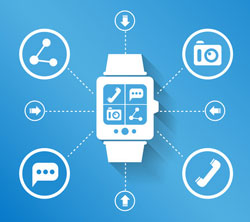
How to measure knowledge worker productivity is a recurrent question, and in my business of reducing information overload my clients often ask me how we can characterize the benefit of my recommendations for action. For years I used to reply, “Easy! You fix a Productometer gizmo to every employee’s skull, and it senses how productive they are!”
Of course, that was nonsense: Characterizing the impact of a productivity program in domains as complex as knowledge work is a challenge requiring less direct means.
It may not remain nonsense for long, though…
Not just a cute gadget
Wearable sensing technology has long been around – first in Science Fiction, and then in various futuristic concept demos. But the arrival of the Apple Watch this year made it much closer to ubiquitous reality. The little marvel measures your heart rate and movements; though useful for fitness training, these measures can already be used to characterize what a worker is doing – and, once you throw in location sensors, where they’re doing it.
In principle, this sort of capability, which will no doubt evolve rapidly, could be a blessing. It is easy to envision health benefits, not just by having your watch alert you to an impending heart attack but also by notifying you of peaks in work related stress. There are, however, other possibilities that directly relate to measuring your productivity.
For example, if your job involves working at a computer (whose doesn’t?) an instrumented watch could easily tell how much you type, how fast you type, and when you just don’t type at all. Patterns of hand acceleration certainly correlate to work behavior (or to non-work). Transmit the information to a company’s server and you could track employees’ behavior over time, compare it to that of their coworkers, and draw conclusions. And of course in many situations – say, call centers – lagging diligence could then be detected in real time and responded to immediately.
The possibilities are endless… but is that a good thing?
What will employees do?
A recent survey of European employees showed some ambivalence: around a third of them could see benefits to well-being and effectiveness, saying they would use wearable technology – for example – to identify their most productive periods and organize their workload accordingly. Yet 52% had reservations about the privacy implications. As well they might.
And yet, when was the last time you saw tech-savvy employees avoid new technology? Email, the all-time killer app, was adopted gleefully and is still indispensable – despite the horrific damage email overload brought to productivity, peace of mind and work/life balance. And the Apple Watch is oh, so cool! You can bet the capabilities will be there, and employers will be sorely tempted to apply them.
What will employers do?
How soon employers will try to apply wearable technology to monitoring employees we’ll have to wait and see, but it could easily happen gradually. Consider the simplest cases: why not apply it to report work hours directly? How about providing periodic health checks? And then…
Let’s assume that monitoring people in real time will be available and dirt cheap (it will).
Let’s assume that employers will want to avail themselves of this opportunity.
What then?
I’ve said that this technology has the potential to benefit people. Take an example: sitting and typing all day can easily lead to CTD and to back problems. With wearable monitors, you could prevent this pain by alerting people to stretch at regular intervals, based on their actual usage pattern.
The problems begin when you want the devices to report back to the “mothership”. That’s when the privacy concerns kick in; that’s where the slippery slope to “Big Brother” begins. Some employers will likely turn wearables into workforce monitoring devices, first for jobs lower on the ladder, then – slowly – to higher ones. And they will pay a price.
The price is twofold. First, over-monitoring is demeaning and infuriating to employees, and is a powerful demotivator. It transmits mistrust, the worst destroyer of workplace harmony. Resourceful employees will probably find ingenious ways to get around it… but if they’re so smart, they might well simply go to a more respectful employer.
The second cost is that people are different, and knowledge workers have different work modes that suit their psychological makeup. One employee may work for hours at a stretch and do good work; another may do just as good a job by taking frequent breaks. Subject them all to a single monitoring algorithm and you’ll force many to work sub-optimally.
So what should you do?
Easy: as IBM used to say… Think! Think of all the implications before you adopt the technology, involve your employees in the thinking process, and tread carefully.
It will pay.
Related Posts
Want to Motivate Employees? Don’t Treat Them Like Children!


I called this “invasion of privacy” & “dumbing down” crap 25 years ago!
Watch “1984” and you’ll see exactly how ‘wonderful’ the ‘ever-watchful Eye’ can be. :/ 🤨😟😤
Oh, what a wonderful way to ultimately control people.. dumb them down so they can no longer think for themselves. “We will think FOR you”. THIS CAN NEVER BE GOOD.